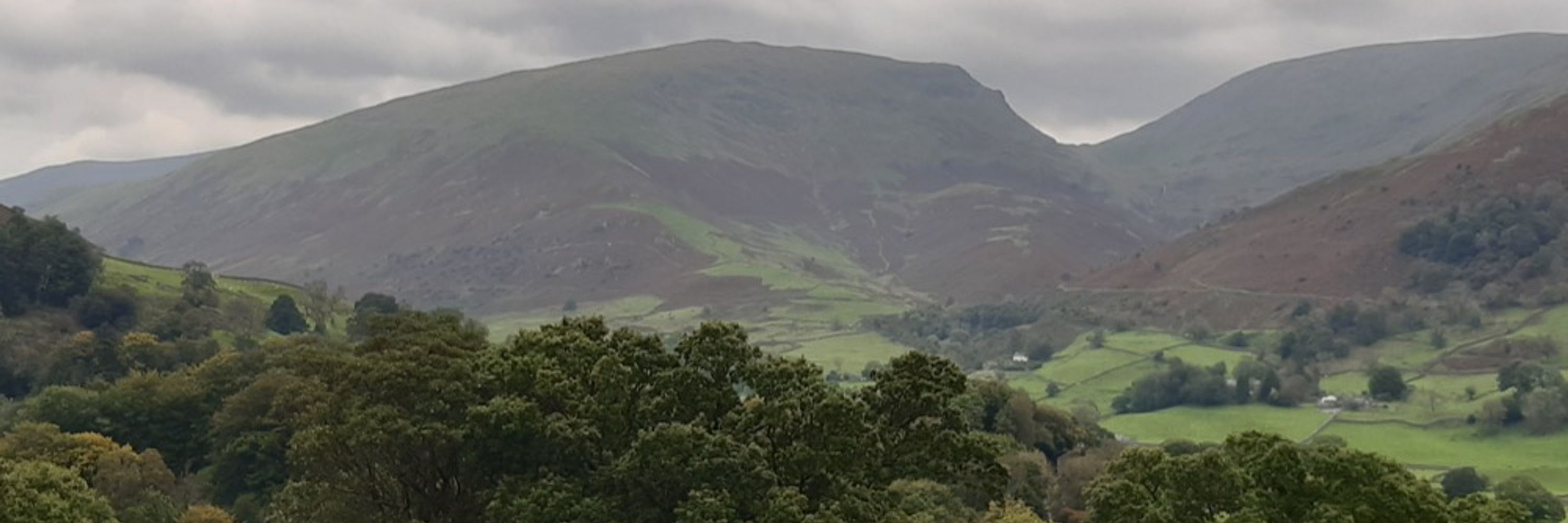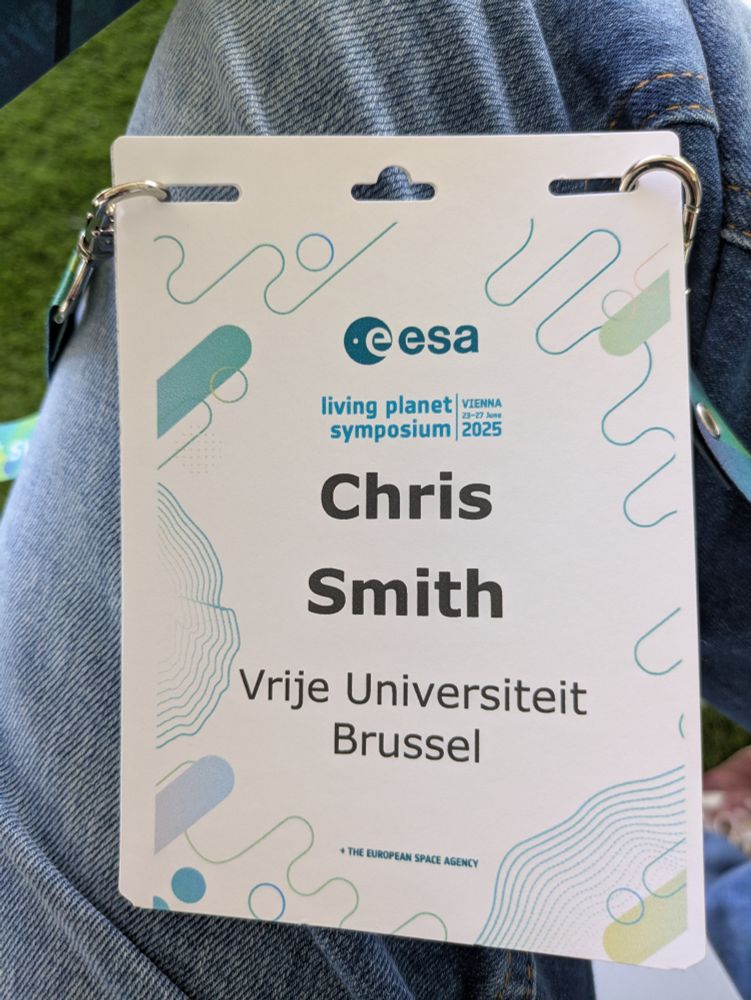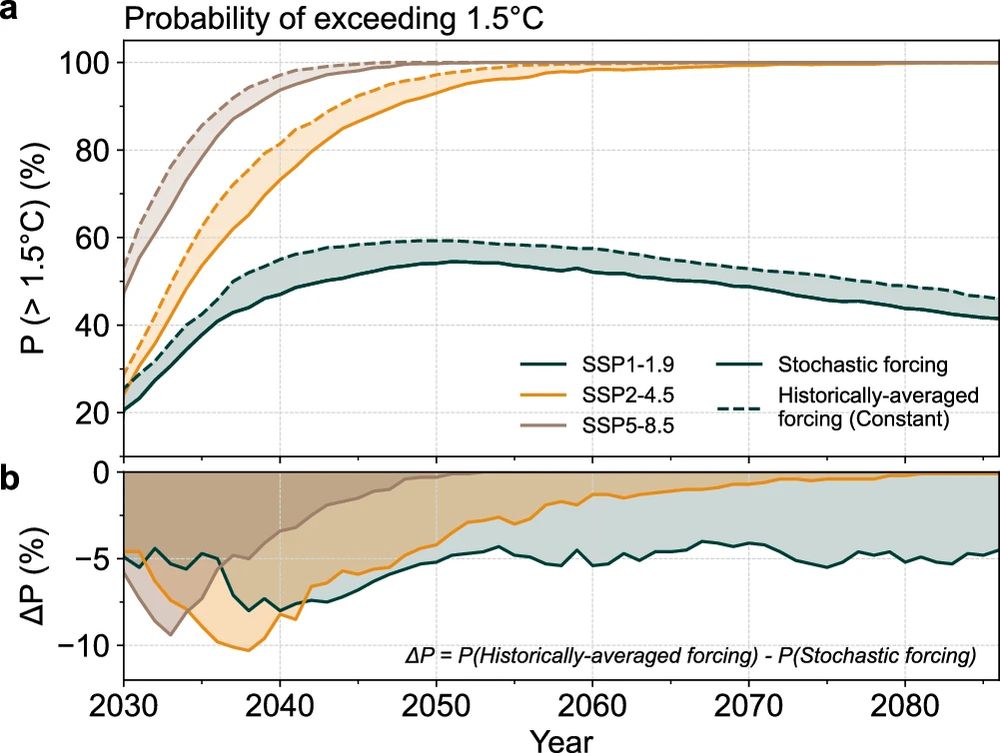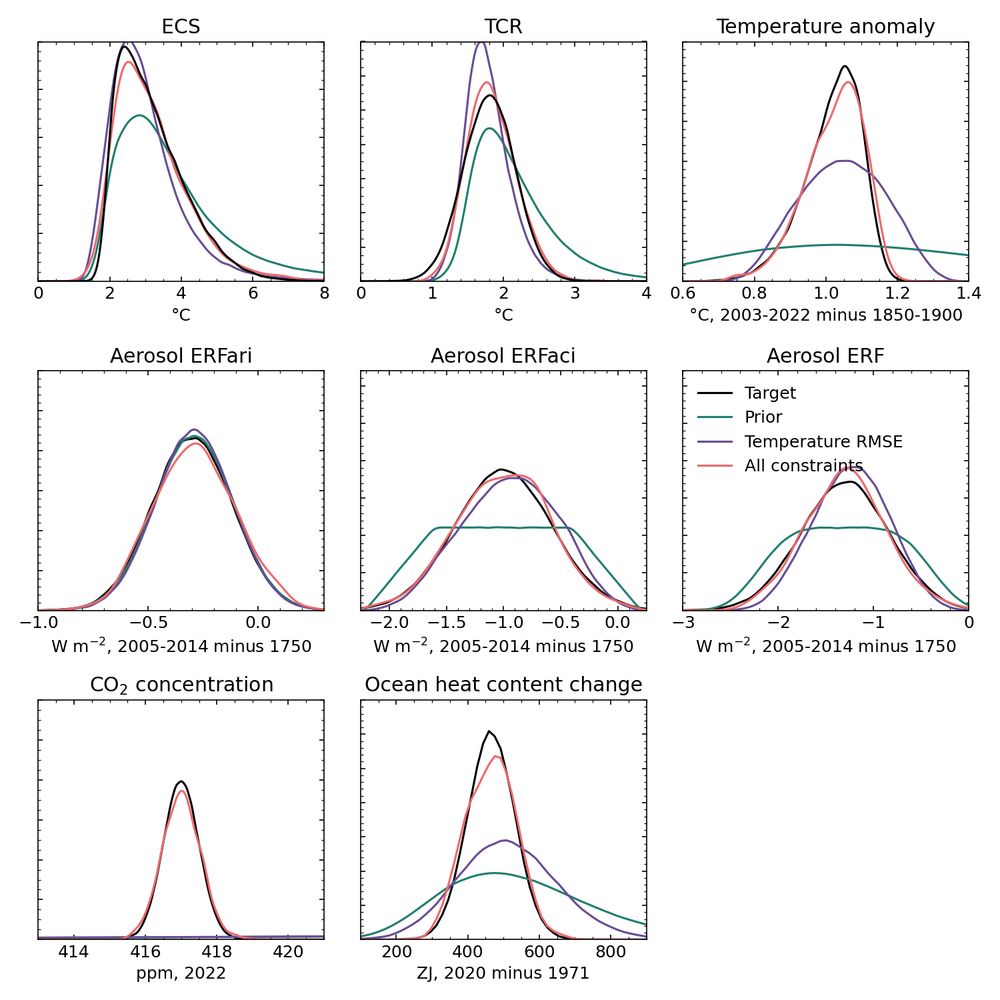
Chris Smith
@cjsmith.be
Climate scientist at Vrije Universiteit Brussel & IIASA. IPCC AR7 CLA. Responsive climate projections. The guy behind the fair model and radiative forcing barchart. Occasional runner and guitarist.
github.com/chrisroadmap | cjsmith.eu
github.com/chrisroadmap | cjsmith.eu
A sneak peak of hopefully what is to come in CMIP7. We ran two CMIP6 climate models in CO2 emissions driven mode to 2300 - and the responses in the long term are very different.
Preprint: egusphere.copernicus.org/preprints/20...
Preprint: egusphere.copernicus.org/preprints/20...

November 7, 2025 at 11:48 AM
A sneak peak of hopefully what is to come in CMIP7. We ran two CMIP6 climate models in CO2 emissions driven mode to 2300 - and the responses in the long term are very different.
Preprint: egusphere.copernicus.org/preprints/20...
Preprint: egusphere.copernicus.org/preprints/20...
Has anybody ever looked at the IPCC AR5 scenario database and run them in a simple climate model? I'm curious to know how many would get close to 1.5°C - probably not many if the earliest net zero CO2 date is ~2060. Interesting to see how ambition has evolved over time at the low end

October 28, 2025 at 3:23 PM
Has anybody ever looked at the IPCC AR5 scenario database and run them in a simple climate model? I'm curious to know how many would get close to 1.5°C - probably not many if the earliest net zero CO2 date is ~2060. Interesting to see how ambition has evolved over time at the low end
Hello world, who else is in Vienna this week?

June 24, 2025 at 1:30 PM
Hello world, who else is in Vienna this week?
Here's @arp-climate.bsky.social presenting on the upcoming process-based carbon cycle in FaIR at #EGU25!

April 30, 2025 at 1:50 PM
Here's @arp-climate.bsky.social presenting on the upcoming process-based carbon cycle in FaIR at #EGU25!
Some of the WorldTrans crew at EGU25 with Axel's poster 👏

April 28, 2025 at 3:55 PM
Some of the WorldTrans crew at EGU25 with Axel's poster 👏
As a corollary, we can also see what this does to projected thresholds of warming exceedance in different scenarios; including volcanoes lowers the probability of exceeding 1.5°C by 5-7% in a very high ambitious scenario.

March 27, 2025 at 3:20 PM
As a corollary, we can also see what this does to projected thresholds of warming exceedance in different scenarios; including volcanoes lowers the probability of exceeding 1.5°C by 5-7% in a very high ambitious scenario.
This water vapour input (green) more than offset the small cooling effect from a increase in stratospheric aerosol optical depth (blue), resulting in a net volcanic radiative forcing (purple) that is above the long-term quiescent baseline value for 2022-2024.

February 13, 2025 at 1:00 PM
This water vapour input (green) more than offset the small cooling effect from a increase in stratospheric aerosol optical depth (blue), resulting in a net volcanic radiative forcing (purple) that is above the long-term quiescent baseline value for 2022-2024.
The water vapour emitted into the stratosphere by the Hunga Tonga-Hunga-Ha'apai volcanic eruption in January 2022 continues to influence climate. The MLS data for stratospheric water vapour is now only available a few days per month, but we can still continue the "tape recorder"

February 13, 2025 at 1:00 PM
The water vapour emitted into the stratosphere by the Hunga Tonga-Hunga-Ha'apai volcanic eruption in January 2022 continues to influence climate. The MLS data for stratospheric water vapour is now only available a few days per month, but we can still continue the "tape recorder"
Best secret santa ever?

December 19, 2024 at 5:28 PM
Best secret santa ever?
Particularly nice is that the climate response in the years after large volcanic eruptions in fair agrees pretty well with the reconstructions too!

December 10, 2024 at 6:46 AM
Particularly nice is that the climate response in the years after large volcanic eruptions in fair agrees pretty well with the reconstructions too!
New preprint!
Using reduced-complexity volcanic aerosol and climate models to produce large ensemble simulations of Holocene temperature
egusphere.copernicus.org/preprints/20...
Using reduced-complexity volcanic aerosol and climate models to produce large ensemble simulations of Holocene temperature
egusphere.copernicus.org/preprints/20...

December 10, 2024 at 6:46 AM
New preprint!
Using reduced-complexity volcanic aerosol and climate models to produce large ensemble simulations of Holocene temperature
egusphere.copernicus.org/preprints/20...
Using reduced-complexity volcanic aerosol and climate models to produce large ensemble simulations of Holocene temperature
egusphere.copernicus.org/preprints/20...
When you have this final posterior, you can go to town on running your own calibrated, constrained climate projections. Here are the SSPs run to 2200, with the historical climate and emissions updated to 2022 constraints.

December 3, 2024 at 8:15 AM
When you have this final posterior, you can go to town on running your own calibrated, constrained climate projections. Here are the SSPs run to 2200, with the historical climate and emissions updated to 2022 constraints.
We end up with a smaller posterior set of fair parameters. I use 841 as standard. I have reasons for choosing this number, which confused the hell out of a reviewer. You get these nice constrained projections that still incorporate uncertainty.

December 3, 2024 at 8:15 AM
We end up with a smaller posterior set of fair parameters. I use 841 as standard. I have reasons for choosing this number, which confused the hell out of a reviewer. You get these nice constrained projections that still incorporate uncertainty.
Second, we can use additional constraints to further refine the projections. We want to ensure our CO2 and CH4 concentrations, and aerosol forcing, is within observational/IPCC uncertainty ranges. We can also use IPCC assessments of emergent variables like ECS.

December 3, 2024 at 8:15 AM
Second, we can use additional constraints to further refine the projections. We want to ensure our CO2 and CH4 concentrations, and aerosol forcing, is within observational/IPCC uncertainty ranges. We can also use IPCC assessments of emergent variables like ECS.
First, one can apply a simple root-mean-square-error matching of the historical simulations compared to observed global mean surface temperature, with an appropriate cut-off. This discards about 90% of the ensemble.

December 3, 2024 at 8:15 AM
First, one can apply a simple root-mean-square-error matching of the historical simulations compared to observed global mean surface temperature, with an appropriate cut-off. This discards about 90% of the ensemble.
Most parameter combinations give you nonsense climate projections. How can we ensure that we get useful output, without throwing out the baby with the bathwater?

December 3, 2024 at 8:15 AM
Most parameter combinations give you nonsense climate projections. How can we ensure that we get useful output, without throwing out the baby with the bathwater?
We then derive distributions of parameters to run fair with, based upon the calibrations, from kernel density estimates that include correlations between parameters, and run the model many, many times (1.6 million in this paper)

December 3, 2024 at 8:15 AM
We then derive distributions of parameters to run fair with, based upon the calibrations, from kernel density estimates that include correlations between parameters, and run the model many, many times (1.6 million in this paper)
We start by calibrating each component of fair: temperature response to forcing, carbon cycle feedbacks, methane lifetime sensitivities, ozone and aerosol forcing, to all available Earth System Models, using simple relationships.

December 3, 2024 at 8:15 AM
We start by calibrating each component of fair: temperature response to forcing, carbon cycle feedbacks, methane lifetime sensitivities, ozone and aerosol forcing, to all available Earth System Models, using simple relationships.
Does anybody know the source of the small difference in Global Carbon Budget between the sum of country-level + bunker fuels (10.27 GtC) and the total from the global budget (10.31 GtC)?


November 21, 2024 at 5:17 PM
Does anybody know the source of the small difference in Global Carbon Budget between the sum of country-level + bunker fuels (10.27 GtC) and the total from the global budget (10.31 GtC)?
#EGU25 session announcement!
Physical and statistical emulators for climate impacts
with @rebeccamayvarney.bsky.social, @yannquilcaille.bsky.social, Greg Munday & Norman Steinert
meetingorganizer.copernicus.org/EGU25/sessio...
Physical and statistical emulators for climate impacts
with @rebeccamayvarney.bsky.social, @yannquilcaille.bsky.social, Greg Munday & Norman Steinert
meetingorganizer.copernicus.org/EGU25/sessio...

November 18, 2024 at 10:41 PM
#EGU25 session announcement!
Physical and statistical emulators for climate impacts
with @rebeccamayvarney.bsky.social, @yannquilcaille.bsky.social, Greg Munday & Norman Steinert
meetingorganizer.copernicus.org/EGU25/sessio...
Physical and statistical emulators for climate impacts
with @rebeccamayvarney.bsky.social, @yannquilcaille.bsky.social, Greg Munday & Norman Steinert
meetingorganizer.copernicus.org/EGU25/sessio...
Got myself involved with three EGU session proposals next year. I like to make little visual cards for the sessions I'm involved with. Here's the first, and here's the session:
Environmental Impacts of Shipping (AS3.15)
meetingorganizer.copernicus.org/EGU25/sessio...
Environmental Impacts of Shipping (AS3.15)
meetingorganizer.copernicus.org/EGU25/sessio...

November 12, 2024 at 1:23 PM
Got myself involved with three EGU session proposals next year. I like to make little visual cards for the sessions I'm involved with. Here's the first, and here's the session:
Environmental Impacts of Shipping (AS3.15)
meetingorganizer.copernicus.org/EGU25/sessio...
Environmental Impacts of Shipping (AS3.15)
meetingorganizer.copernicus.org/EGU25/sessio...
End of an era. Tomorrow this will get sold. From 2005 to 2008 I was one third of Nottingham alt-grunge-prog* band The Crimson Roadmap, hence the username everywhere on the internet. The jack connection has gone and I need to make space. Official end of my youth
*now a genre
*now a genre


October 21, 2024 at 8:45 PM
End of an era. Tomorrow this will get sold. From 2005 to 2008 I was one third of Nottingham alt-grunge-prog* band The Crimson Roadmap, hence the username everywhere on the internet. The jack connection has gone and I need to make space. Official end of my youth
*now a genre
*now a genre


September 27, 2024 at 9:04 AM
RCP8.5 gets a very bad rap - but it's a damn useful scenario for calibrating impacts and damage functions, as well as extending more "realistic" scenarios beyond the end of the century. A sizeable proportion of the RFF-SP scenarios exceed 8.5 W/m2 in the 22nd/23rd Centuries.
rdcu.be/dUirx
rdcu.be/dUirx

September 19, 2024 at 3:44 PM
RCP8.5 gets a very bad rap - but it's a damn useful scenario for calibrating impacts and damage functions, as well as extending more "realistic" scenarios beyond the end of the century. A sizeable proportion of the RFF-SP scenarios exceed 8.5 W/m2 in the 22nd/23rd Centuries.
rdcu.be/dUirx
rdcu.be/dUirx
Great to stop by for an interview at ORF (the Austrian state broadcaster) yesterday to talk about climate change. Will be out on FM4 next Friday as part of Chris Cummins' show

April 12, 2024 at 5:28 AM
Great to stop by for an interview at ORF (the Austrian state broadcaster) yesterday to talk about climate change. Will be out on FM4 next Friday as part of Chris Cummins' show

